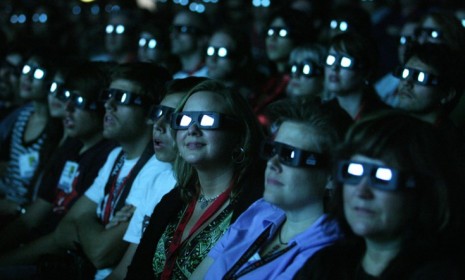3D's fading promise
Films that create the illusion of depth perception were supposed to revolutionize the movie industry. What happened?

When did Hollywood first use 3D?
It took off in the 1950s, when the studios saw 3D features as a way to lure customers away from their new television sets. But most filmmakers treated the technology as a gimmick, and after a string of mediocre movies with titles like Cat-Women of the Moon, 3D survived only in theme parks and the occasional animated feature. It was not until the 2009 release of James Cameron's Avatar, filmed using new, high-definition 3D cameras, that 3D realized its potential in a mainstream film. The sci-fi epic quickly became the highest-grossing film of all time, with 85 percent of its revenue coming from 3D screenings. Major studio heads said the new technology — and the hefty premium they could charge for it — would reverse falling box-office revenues. "There have been three revolutionary movements in the film world," Jeffrey Katzenberg, chief executive of DreamWorks Animation, said in 2010. "The introduction of sound, color, and now 3D."
Did the enthusiasm last?
The Week
Escape your echo chamber. Get the facts behind the news, plus analysis from multiple perspectives.

Sign up for The Week's Free Newsletters
From our morning news briefing to a weekly Good News Newsletter, get the best of The Week delivered directly to your inbox.
From our morning news briefing to a weekly Good News Newsletter, get the best of The Week delivered directly to your inbox.
No. Audiences have clearly become very ambivalent about 3D. This summer, for the first time, a majority of viewers chose to see a 3D picture, Pirates of the Caribbean 4, in the 2D format, thereby avoiding the higher price of 3D tickets. The same fate befell Kung-Fu Panda 2, Green Lantern, and the final Harry Potter sequel, all of which were expected to reap huge profits from 3D screenings. And if 3D was supposed to get audiences back into movie theaters, it didn't work — cinema attendance dropped to a 17-year low this summer. Analysts are now predicting that the audience drop-off for 3D movies will only get worse, and investors are taking flight. RealD, which leases 3D equipment to movie theaters, saw its share price plummet 70 percent over the summer. "U.S. consumers are increasingly rejecting 3D movies," said Wall Street analyst Richard Greenfield.
What don't audiences like?
The price, for one thing. Movie theaters charge a $4 to $5 premium for a 3D ticket, and many consumers no longer think it's worth the cost. That may be partly due to this year's glut of mediocre, poorly made 3D movies. Studios released 18 movies in the format this summer, compared with seven the previous summer. Many of them were hastily converted in post-production, rather than being filmed using 3D cameras, and ended up with poor effects that were too dark to see properly. "It produces what I call 2-and-a-half-D," said Cameron. Studies have found that as many as 30 percent of viewers become nauseous while watching movies in 3D format, which requires a viewer's eyes to focus on the screen while converging on the constantly changing distance of the 3D images. That unfamiliar visual experience, Northwestern University ophthalmology professor Michael Rosenberg said, "translates into greater mental effort, making it easier to get a headache."
What do directors think?
A free daily email with the biggest news stories of the day – and the best features from TheWeek.com
Some influential Hollywood filmmakers think 3D is a technological stunt with no real value. Christopher Nolan, director of Inception, refused to make a Batman sequel in 3D. "On an experiential level, I find the dimness of the image extremely alienating," he said. Walter Murch, the Oscar-winning editor of Apocalypse Now and The English Patient, rejects the technology as "dark, small, stroby, headache-inducing, alienating, and expensive." But other directors are still intrigued with the possibilities of the format. Martin Scorsese, Steven Spielberg, and Ridley Scott are all releasing 3D movies this winter. And Cameron's sequels to Avatar — due in 2014 and 2015 — mean 3D movies will still generate a lot of cash.
Will other 3D films be made?
Probably. The format still makes money for the studios. Even though fewer Americans went to the movies last summer, domestic box-office revenue was up by 1 percent, buoyed by the higher ticket prices for 3D movies. International audiences find the format exciting — sales of 3D tickets rose in Japan, the U.K., and Russia last year. There's also evidence that cinemagoers in the U.S. are still prepared to don 3D glasses for the right film; the recent 3D remake of The Lion King drew big audiences. Some industry experts believe 3D will become much more popular once the technology evolves to the point where glasses aren't necessary. That's estimated to be about a decade away.
So what's the future of 3D?
It's likely to exist as a niche market, rather than as the future of cinema. "We are going to be selective in terms of where we deploy 3D," said Brad Grey, chief executive of Paramount Pictures. "It needs to be with the right storyteller, the right project, and the right director." Hollywood is realizing that audiences won't pay a surcharge to see a mediocre movie with bad 3D. "A number of people…thought they could just deliver a kind of low-end, crappy version of [3D] and people wouldn't care," said Katzenberg recently. "Nothing could have been further from the truth." The onetime 3D evangelist said that if the studios deliver quality films, the format will return to favor. "I think it will take us a while, but we'll earn it back."
3D in your living room
Hollywood was hardly alone in hoping to reap big profits from 3D technology. The television industry also leaped onto the bandwagon, launching expensive 3D TV sets to bring the technology into the nation's living rooms. It has flopped there even worse than it has in the movie theaters. Fewer than 3 million 3D TVs are likely to be sold this year, a fraction of the 18 million in annual sales predicted as recently as January. Viewers are reportedly turned off by the cost of the new sets, which can top $1,300, the paucity of quality 3D content, and the thought of having to wear special glasses to watch TV at home. A recent study found that more than half of consumers seeking a new TV said they wouldn't consider a 3D set. Cable magnate Mark Cuban, head of HDNet, is standing back, too. "3D on TV is a bust," he said.
-
 Is the Chinese embassy a national security risk?
Is the Chinese embassy a national security risk?Today’s Big Question Keir Starmer set to approve London super-complex, despite objections from MPs and security experts
-
 Why X faces UK ban over Grok deepfake nudes
Why X faces UK ban over Grok deepfake nudesThe Explainer Ofcom is investigating whether Elon Musk’s AI chatbot breached Online Safety Act
-
 The ‘eclipse of the century’ is coming in 2027
The ‘eclipse of the century’ is coming in 2027Under the radar It will last for over 6 minutes